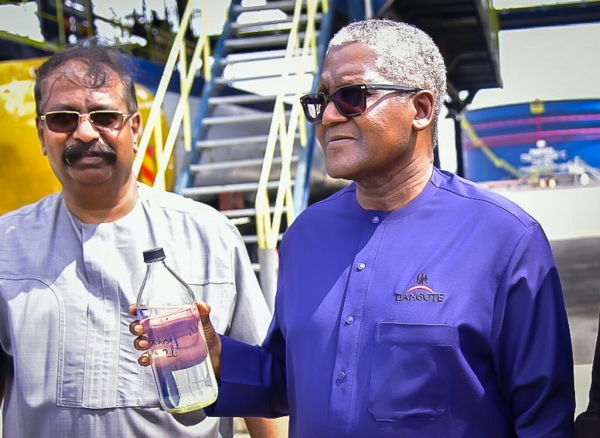On Tuesday, Aliko Dangote showed off the new colourless petrol from his refinery — a stark contrast to the colour which Nigerians are used to, which is typically yellowish or reddish-pink. This made people question the quality of petrol in Nigeria.
“You might think it looks different, but this is the real thing,” Dangote said, while pointing at the bottle.
“You will now have good petrol and your car engines will last longer. You won’t have engine problems like we used to. It won’t happen at all.
“The quality here is as good as anywhere in the world. We will make sure nobody beats us on quality.”
This statement and the colourless appearance of his product have stirred conversations and doubts about the quality of petrol in Nigeria.
Some think the yellowish or reddish-pink colour widely distributed in the country is of inferior quality because of Dangote’s comments. But does the colour really matter?
WHAT IS PETROL?
Petrol or gasoline is fuel for cars. The National Geographic Society describes the fuel as liquid that is clear, yellowish, and burns easily. Petrol is made from crude oil, which is usually black or dark brown. But crude oil can also be yellowish, reddish, tan, or even greenish.
WHAT IS PETROL’S TRUE COLOUR?
Car from Japan, a car marketplace in Japan, says petrol has no original colour, as it is a mix of various other gasoline and hydrocarbons. The marketplace said hydrocarbons, typically heptane and octane, also come in different types for different vehicles.
According to the platform, the colour can vary from yellow, orange, or brown depending on what is added to it.
“So, the answer is that the colour can vary! It will be no wrong if we say that gasoline has no colour or it is simply clear. Take a glass of clean water and see how it looks; this is how exactly the gasoline looks, in reality. It is only after we mix other substances into it when it becomes yellowish in colour. So, next time someone asks you what colour is gasoline, the answer would be it has no colour, it is clean,” the website stated.
IS COLOURLESS PETROL THE BEST?
Joe Nwakue, former chairman of the Society of Petroleum Engineers, said the colour of the petrol can change during production.
“When you produce it (petrol), it’s light. It’s almost like water. If you want to distinguish between different grades, you can colour them differently. You can put a colour agent,” Nwakue told TheCable.
“If nobody does anything to alter the properties, the colour on its own does not signify the quality. But the maker can decide what grade of petrol they’re producing and colour them differently so the person either selling or buying it knows which one it is.”
HunterLab, a colour measurement spectrophotometer manufacturer in Virginia, US, said checking the colour scientifically helps ensure petrol is made to the right standards.
“When it is tested right, you can identify the genuine quality of the gasoline. After that, you can decide which one is good and which one has a bad effect on the car’s engine,” HunterLab stated.
“Colour is a key indicator of quality in petroleum-based products and developing a colour range is an important part of the refinement process.
“A colour range can often be used for monitoring contamination and quality control. Petroleum-based products make up a wide variety of manufactured goods; with consumers relying on colour for acceptability, it’s crucial to meet the quality standards of visual perception.”
Akpunonu Okey, a professor of petroleum geosciences, Nnamdi Azikwe University, told TheCable that the type of crude oil used is also a determining factor for the colour of petrol.
“What determines the colour is the type of crude oil, not the quality,” Okey said.
“What determines the colour is the presence of sulphur and then the imperial history of petrol determines the quality whether it will be light crude or heavy crude. Imperial history is determined by the temperature, they work hand in hand.”
Hence, it is safe to say that the colour of the petrol does not necessarily indicate if it is of good or bad quality.

